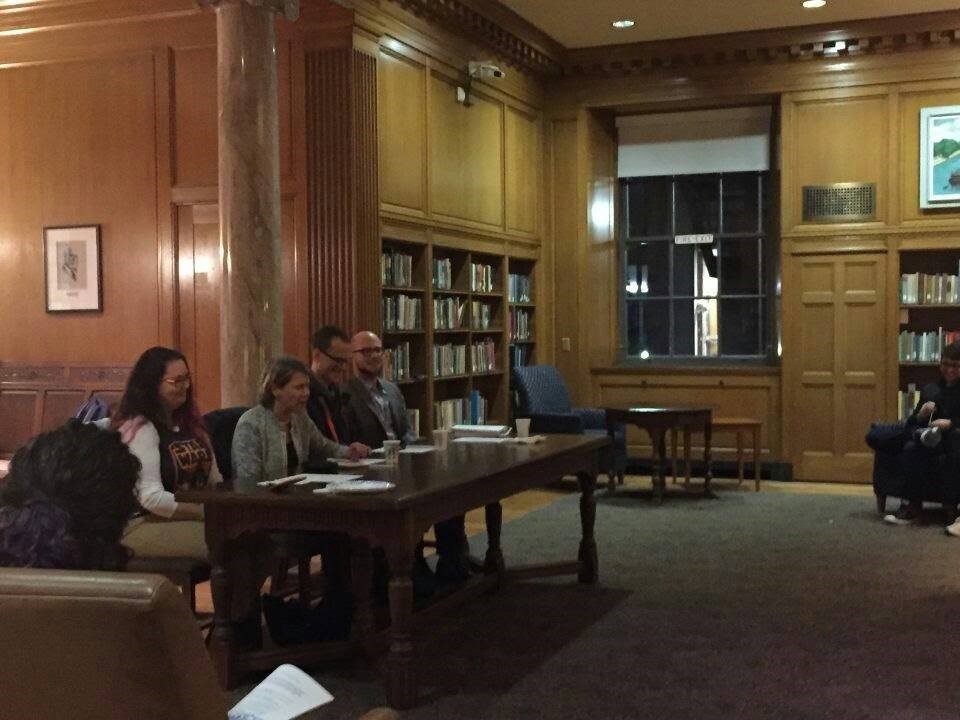LOGOS Panel: Technology and Creativity
by Sara Kowalski, Class of 2017, Humanities Fellow
Every fall semester, LOGOS hosts one of its popular panels. These events get to the heart of issues creative minds at Rochester want to understand. Previous years have explored “Art as Therapy,” “How to Handle Rejection,” and so on. This year’s panel focused on the matter of creative arts in the digital age.
This year’s panelists were Professor Joanna Scott and Joel Burgess from the English department, Janelle Hart, the University’s graphic designer, and Professor Cary Peppermint, who is part of the Environmental Humanities Program, the art and art history department, and the digital media studies program.
Analyzing Literature with Computers
How is technology influencing academia? Many scholars are now using text-mining and bibliometrics to study literature. In other words, they program a computer to analyze a text based on certain parameters, then they feed a work or a corpus of works into the computer, and the computer outputs the analysis, which is then interpreted by the scholar.
Screen-Reading
Can we read dense material on a screen as well as we do on paper? Certain studies say we can’t. It seems that, “as we become more literate, the more people choose not to read.” This may be because we have two types of literacies these days—one for reading digital text, and one for reading physical text. It’s a widely acknowledged fact that fewer and fewer people are reading books (ebooks or otherwise), but almost everybody texts and reads online. The question is: is this still reading and writing? Many families in Silicon Valley send their children to no-screen schools. This may be for a good reason.
Studies have found that easy-to-read fonts “go in one eye and out the other” (so to speak), whereas difficult-to-read fonts force your brain to decipher and interpret the text. This may influence how we read digital texts, which are usually written in short, simple bursts of text formatted in easy-to-read fonts.
Evolution of Language
Has our language “dulled” in the wake of the digital age? The answer isn’t easy. It has “shifted” certainly, but whether this is a shift in a positive or negative direction is largely a matter of opinion at this point. For example, “text-talk” is very useful to graphic designers because they are able to make advertisements “punchier” by using less text to get the same amount of information across.
Another way to look at the situation is to admit we have lost certain aspects of our language, but to accept this loss as “inevitable” and strive not to forget what we have lost so we do not lose the literary masterpieces of our past.
Can emojis be used as a universal language? Some scholars believe that our culture is becoming more visually-based instead of literary. A progression can be traced from oral story-telling, to written story-telling, to visual story-telling. However, in a primarily visual culture, we “lose presence.” And we must keep in mind that the oral, written, and visual modes each interact with memory differently.
Are corporations dictating the future of our language? The driving force of the digital age is the speed and efficiency of moving money around.
The Liberation of Information
Does the internet “liberate” information and art? Before the widespread accessibility offered by the internet, only the elite and privileged were able to dictate what was “good” art, but now the general public decides what is good and what is bad. However, this is not entirely true. Privilege is by no means erased on the internet. And there are many ways to cheat the system. For example, it is easy to program bots to write positive and negative reviews on Amazon, which means anyone with the right level of skill could send a book to the top of the best-reviewed list—or to the bottom. In many other ways, information and art has been constrained and limited.
On the other hand, the Internet has allowed artists and authors to accumulate followers, develop a stronger connection with their fans, and document and share their creative process unlike ever before.
How can we determine real and not real, true and untrue in the digital world? There is just so much on the internet, and it is often difficult to sort through all the junk. This is part of the reason we are so vulnerable to exaggerated and false news stories, why we may read and view acts of plagiarism without ever being the wiser, and why we are often blind to news and perspectives that circulate outside our filters.
This is related to the dilemma of sifting through all the junk to find true gems. For artists and writers self-publishing online, this means an added challenge of trying to compete with a lot of sub-par material just to get theirs seen.
In the end, no one quite knows where the digital age is taking us, and what new opportunities and challenges we will encounter as technology continues to develop at the rate it does and new media and machines continue to inundate our lives. We must only be “agile, aware, educated, and skeptical.” We must continue to have conversations like these—students and faculty alike.


